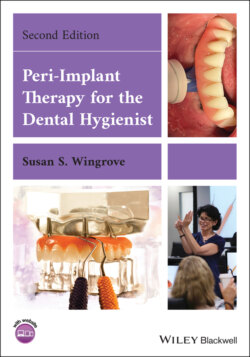Читать книгу Peri-Implant Therapy for the Dental Hygienist - Susan S. Wingrove - Страница 33
Medical history/risk assessment
ОглавлениеRisk assessment questions are a vital part of a comprehensive medical history and implant treatment plan. Health risk factors include uncontrolled diabetes, history of poor wound healing, and any diagnoses of systemic diseases. Risk factors, such as age, gender, obesity, smoking, functional habits, oral health (biofilm), and socioeconomic status are also important. If these factors are combined it could make any implant treatment case more complicated and a risk for a successful case outcome.
One standard risk assessment often used with patients is offered through the Academy of Periodontology (AAP). Twelve questions on age, gender, oral health (bleeding gums, loose teeth, recession, missing teeth), smoking or tobacco use, habits (frequency of dental visits, flossing, brushing), oral‐systemic diseases (including periodontal disease), and genetics are used to determine a risk score. Etiology risk factors include all the risk factors mentioned on the AAP Risk Assessment in addition to caries rate and occlusion (bruxism), to be taken into consideration in determining whether a patient is a good candidate for implant therapy. If a patient has a high caries rate, he or she is actually at low risk for implant therapy. For example, a controlled diabetic patient would benefit with implant therapy because the implants would not decay.
Occlusal issues such as bruxism make implant therapy a higher risk due to the possibility of overloading the implants with occlusal forces, which could lead to bone loss or implant failure. Treatment to correct bruxism and fabrication of an occlusal guard can greatly increase the success rate of implant therapy for these patients.
For a periodontal disease patient, the evidence from both longitudinal and cross‐sectional studies shows that a history of periodontal disease is a higher risk factor and indicator of peri‐implantitis (19). A clear indicator that prior to placing an implant, strong consideration should be made to bring the patient into a stable periodontal condition, is the key. Once a periodontal patient, always a periodontal patient, and these patients should be kept on a more frequent recare maintenance schedule. All the factors that caused this patient to have periodontal disease are still present.
Smokers, once considered high risk, according to the 2017 AAP/EFP World Workshop to develop new classifications and conditions stated; “there is currently no conclusive evidence that smoking constitutes a risk factor or indicator for peri‐implantitis” (19). Studies vary widely on this topic, but the results of smoking as a risk factor can be related to other risk factors like previous periodontal disease. Many experts believe biofilm accumulation, smoking, and radiation are the top three risks factors for peri‐mucositis. Patients who quit smoking or underwent a smoking cessation program can however improve their overall health and therefore greatly increase the success rate for implant therapy. Patients who have had radiation therapy, pathological conditions in the bone, active periodontal disease, and/or acute infections are contraindicated for implant therapy. These contraindications can be reversed with treatment at a slightly lower success rate. See the Appendix for resources on inflammation and organizations that offer risk assessments and are up‐to‐date on research on peri‐implant therapy risk factors.
